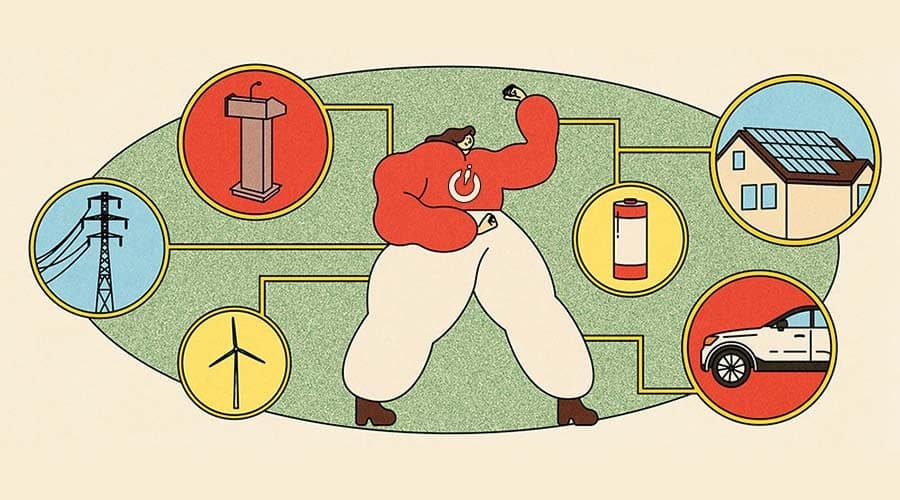This blog comes from the desk of Wendy Philleo, the Executive Director of Generation180.
As we head into a very busy fall season, I wanted to take a moment to reflect on the new clean energy landscape before us and what it means for Generation180’s work and our potential for impact.
A year ago, the Bipartisan Infrastructure and Jobs Act (IIJA) was being signed into law. That $550B action paved the way for the $54.2B in the CHIPS and Science Act (CHIPS) and the largest investment in clean energy America has ever made with the $369B Inflation Reduction Act (IRA) signed into law this summer.
Combined, the brain (CHIPS), backbone (IIJA), and engine (IRA) will spur clean energy innovation while building out essential infrastructure to scale clean energy technologies quickly. They will also create long-term certainty for industry to keep innovating and driving down costs.
All of this is to say, these three pieces of federal legislation are a very big deal. They make the biggest investment in clean energy and climate in U.S. history, and while it took decades of advocates demanding action to get here, arguably the most challenging work is now ahead of us in implementation. Now that we have federal funding, let’s get to work and start proving how clean energy benefits all Americans.
While it took decades of advocates demanding action to get here, arguably the most challenging work is now ahead of us in implementation.
Here’s where we see the greatest gains for solar schools, electric vehicles (including school buses), and homes.
More Schools Powered by Clean Energy
With nearly 50 million students attending over 130,000 K-12 schools, the education sector – schools in particular – have an important role to play in our country’s transition to clean energy. Our recent Brighter Future report found that since 2015, the amount of solar installed at K-12 schools has tripled. Despite this growth, only 9% of schools have gone solar.
We are on the path to a brighter future, but we have a long way to go to reach our goal of 100% clean energy powered schools. More than $500 million in new federal funding will soon go to readying schools across the country for clean power solar installation and more energy efficiency. These investments benefit schools and the climate while improving indoor air quality and introducing Pre-K students to STEM. Schools ready to go solar can find out more here.
How students get to class each day also matters. There are nearly half of a million school buses on the road today, and the vast majority are dirty diesel buses. The millions of children currently riding these buses are breathing in toxic tailpipe pollution, and we have the opportunity–with more than $5 billion in federal funds for school districts–to switch to clean, zero emissions buses, charging infrastructure and operations.
Electric buses improve air quality and health outcomes, particularly for low-income communities and communities of color that disproportionately suffer the harmful effects of air pollution. Switching all of the nation’s school buses to electric would reduce the emissions equivalent to taking over 1 million cars off the road.
Electrification of Everything Becomes Easier
Which leads us to the choice that all drivers have to make their next car electric. The recent legislation has incentives that make EV ownership a no-brainer with rebates for new and used electric vehicles, $5 billion to build the nationwide network of fast chargers deployed across all 50 U.S. states, and the added benefit of supporting a renaissance of American jobs and manufacturing with EV battery plants and semiconductor factories dotting the country.
U.S. automakers have picked up on this market demand signal and are working to deliver new EV models at unprecedented speed. With transportation being the leading source of climate-harming carbon emissions in the United States, EV adoption could come at no better time. Our national Electrify Your Ride campaign is helping to capitalize on national momentum around electric car driving by busting myths and encouraging Americans to sign the Going Electric pledge.
Electrifying your life may begin with a major decision like owning an EV, but it doesn’t stop there. Choices we make every day–like what kind of transportation we use, how we heat the air and water in our homes, cook our food and dry our clothes–can all be electric.
Americans in every zip code across the country can reduce their energy bills and electrify their homes through new federal tax credits and direct rebates that offset up-front costs. In addition to solar system and EV rebates, benefits for homes include credits for electric stoves, dryers, battery storage, heat pump water heaters, breaker box upgrades, home energy audits, electrical wiring, weatherization, and efficiency improvements. These seemingly small changes add up to big benefits for your wallet, climate, and personal comfort.
What You Can Do
Through this influx of new federal funding, individuals are incentivized to take action. For specific steps you can take, check out our list on how to make your energy matter. The best way for individuals to maximize their impact is to use their voice to influence change at the local, state, and national level.
The best way for individuals to maximize their impact is to use their voice to influence change at the local, state, and national level.
We need to discuss this issue at the dinner table and in our daily lives. Almost 80% of Americans support climate policies, yet a recent study shows that we underestimate popular support for climate action by nearly half. Americans need to raise their voices on this issue and show up to vote for clean energy at every election, whether it’s a local, state or national race.
While this nearly $1 trillion investment spanning the next 10 years is significant, the process of drafting and passing these bills largely left out environmental justice communities – key voices who experience frontline injury from entrenched fossil fuel interests across the U.S. These investments are only a beginning in terms of supplying critical resources to bolster community resilience to floods, hurricanes, wildfires, and other disasters made worse by climate change.
Unprecedented Times Call for Unprecedented Communications
We are in uncharted territory with this new funding. For this earthshot to be successful, organizations, leaders, and advocates will need to double down on efforts to help schools and communities understand and utilize these new clean energy investments.
We need a historic investment in communications and outreach to help Americans take advantage of these incentives. These incentives are useless if Americans don’t even know about them. In addition, we need to pay close attention to state implementation to ensure rapid execution and deployment of the funding in these bills and keep the pressure on at the local and state levels.
This is a moment for our country that we will never get back. We have a limited window to make the changes we need in time. Fortunately, we have the solutions and public support to fight climate change is at an all-time high. We just have to step on the accelerator. Our collective momentum as Americans to demand a better – a cleaner energy future for all – is dependent on what we do in the coming years to make the clean energy balancing act finally tip in our favor.
Together, we’ve got this.















